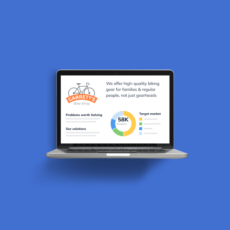Kody Wirth is a content writer and SEO specialist for Palo Alto Software—the creator's of Bplans and LivePlan. He has 3+ years experience covering small business topics and runs a part-time content writing service in his spare time.
What is a Business Model and How to Choose One

3 min. read
Updated January 5, 2024
How will your business make money?
You aim to answer that by selecting and outlining your business model.
Let’s go over the basics, common types, and how to choose the right option for your business.
What is a business model?
A business model describes how your company plans to make money. It outlines what you sell, who you sell to, and your expenses.
If you’re a new business, use a business model to determine if your business idea is viable, attract investors, and guide your overall management strategy.
If you’re an existing company, use it as the foundation for forecasting and reviewing your business plan.
What are the key components of a business model?
A business model can be broken down into three parts:
- Everything it takes to make something: Design, raw materials, manufacturing, labor, etc.
- Everything it takes to sell that thing: Marketing, distribution, delivering a service, and processing the sale.
- How and what the customer pays: Pricing strategy, payment methods, payment timing, etc.
Types of business models
Don’t reinvent the wheel. Start with a common or industry-specific business model and adjust to your needs.
Brought to you by
Create a professional business plan
Using AI and step-by-step instructions
Create Your PlanSecure funding
Validate ideas
Build a strategy
How to choose the right business model
Follow this process to create a business model that aligns with your business goals and the needs of your target customers.
1. Revisit the market and your competitors
Focus your research efforts on how your business can provide value in the market. What features will help you stand out and sell more?
This will require you to take a thorough look at your competitors. What opportunities exist for you to do something new, different, or better?
Lastly, review how they are selling their products. Is it successful? Are there business models in other markets that could work here instead?
Want to learn more? Click here for more on market research.
2. Understand how your customers buy
How you sell needs to align with customer needs and expectations.
Dive deep into your customer’s purchasing behavior.
- Do they prefer one-time purchases or subscription models?
- Online or in-store?
- Free trials or money-back guarantees?
Understanding their preferences allows you to tailor your business model to align with established buying habits.
3. Focus on the problem and your solution
Every successful business solves a problem.
Clearly define the problem and how your product or service provides a unique solution.
- What makes you different?
- How does that affect costs? Pricing?
With customer preferences in mind, consider “what is the best way to deliver your solution?” This should bring you closer to a business model that aligns customer needs with your business goals.
4. Experiment and test multiple business models
Don’t be afraid to try different models. Start with a hypothesis, test it in the market, gather feedback, and refine it.
Through trial and error, businesses often find the model that fits best. Ideally, you’ll end up with multiple revenue streams that can strengthen your business performance.
How do you know if your business model will be successful?
A successful business model must collect more money from customers than it costs to make the product. This is your profit—simple as that.
Remember, you don’t need to invent a new business model. Instead, take an existing business model and tune it to fit the needs of your customers.
Once you do, you can dig deeper into the next step for starting your business—selecting a pricing strategy.


.png?format=auto)






